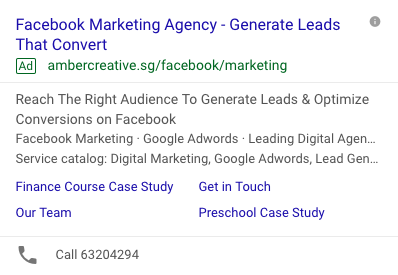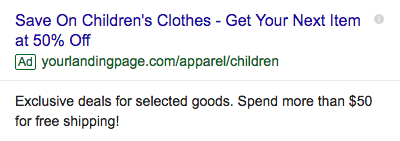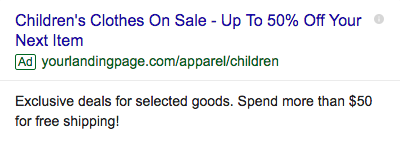One of the scariest things in a digital marketer’s world is spending too much on an underperforming campaign. We’ve all been there – refreshing AdWords constantly and hoping a conversion would magically appear. If this is the case, you might want to revise your campaign and diagnose what may be hindering your campaign’s performance.
There can be several reasons why your campaign is not performing. Most help sites, articles and marketing companies would say that this is because the quality score is reduced.
The Quality Score of your ads determines its frequency, position, and cost per click on Google’s search network. Quality Scores depend on the following:
- Click-Through Rate
- Relevance of keywords to the ad group
- Relevance and quality of post-click landing page
- Relevance of ad text
- Historical AdWords account performance
Ads with a good quality score will appear more often at a better cost per click, while ads with poor quality scores are more costly and may not even appear at all.
However, a weak quality score is not the only reason for your underperforming campaign. Here is a list of 10 common AdWords mistakes, both related and unrelated to Quality Score.
Are You Making Any of These 10 AdWords Mistakes?
1. post-click landing page experience
Many digital marketers focus on creating perfect ad copies but forget that the user experience beyond the ads is just as valuable. post-click landing page experience is an essential component of your Quality Score so that a poor post-click landing page experience can affect the visibility of your ads.
Solution
Here is what a good post-click landing page experience entails:
- Quick loading speeds – nobody likes pages that load slower than molasses.
- Mobile optimization – it is highly recommended to create mobile versions of your post-click landing page to facilitate a mobile user’s experience.
- Aesthetic content – a readable and visually appealing post-click landing page can help users find information and make decisions quicker on your post-click landing page.
- Clear Call-To-Actions (CTAs) – placing clear CTAs around your post-click landing page helps to drive conversions.
2. post-click landing page irrelevance
After ensuring your post-click landing page experience is optimized, there is still one more crucial check for your post-click landing page: its relevance. Imagine clicking on an ad for ‘chocolate cakes’ hoping to order a delicious chocolate cake, but end up on a post-click landing page for ‘vanilla cakes.’ Though it may not seem like its a big deal, it would be detrimental to your ad’s quality score, as the post-click landing page is perceived as irrelevant to the ad.
Solution
For maximum relevance, start by grouping relevant keywords in an ad group. Next, craft post-click landing pages specific to the ad group. Instapage is an excellent platform for creating post-click landing pages to increase conversions. Lastly, link the post-click landing pages with the ads from the same ad group and, voila! Crisis averted. See how we used this is a simple yet highly effective method to generate leads at a low cost.
3. Directing to the home page
Another mistake regarding post-click landing page relevance is directing users to your website’s homepage, instead of the specific web page. This is quite common amongst e-commerce businesses. Even though the relevant web page can be navigated to from the home page, directing users to the home page will still damage your quality score.
Solution
If you were running an e-commerce business selling clothes, and your ad is for ‘children’s apparel,’ your ads should be directed to the page on children’s clothes rather than your website’s homepage of your website. Always link your ads to a page that is directly relevant.
4. Poor keyword choices
Irrelevant keywords and keywords with low search volume are bad news for your quality score. If you have not been getting relevant results, then grab a coffee and a comfortable chair because it is time to start revising those keywords.
Solution
You should not have more than 20 keywords per ad group, as this could mean that your keywords and ad copies are not related. Pause keywords that are irrelevant and/or not converting to avoid excessive spending. Then use keyword planner to add fresh new keywords with high search volumes. Lastly, make use of keyword matches to get the most bang for your buck. To generate impressions, broad match is the way to go. To drive conversions, use phrase and exact matches.
5. Lack of negative keywords
Google isn’t perfect. Even if you picked out the best set of keywords, your ads might still appear in searches that are irrelevant. For instance, if you had ‘marketing’ as a keyword, your ad might appear next to searches for eggs, vegetables, groceries, etc. This is where negative keywords are useful in helping you avoid paying for irrelevant searches.
Solution
Start adding broad, phrase or exact match negative keywords to your ad group or campaign. For example, if you were advertising your marketing company, you could add ‘eggs,’ ‘vegetables,’ ‘groceries’ as negative keywords. If your campaign has been running for a while, look through your search terms report and add irrelevant searches as negative keywords.
Mistakes unrelated to Quality Score:
6. Lack of targeting
Targeting is extremely useful in directing your ads to the audience you want and drive conversions. This also ensures that you do not pay unnecessarily for clicks that won’t convert.
Solution
Location, audience and device targeting are some ways you can narrow down your audience. Choose targeting strategies based on your business goals. If you are looking for customers to purchase your products in your home country, use location targeting, so you do not pay for clicks from overseas customers that you cannot reach. Furthermore, it may be easier to reach customers via mobile rather than desktop targeting if your customers are always on the move.
7. Not using extensions
Ad extensions are great. Undoubtedly. They help your customers navigate your site and take action quickly without even going to your post-click landing page. But there is a more practical benefit of using ad extensions – they make your ad bigger! The bigger your ad, the more real estate your ad takes on the search page, the higher the chances of your ad getting noticed and clicked are!
Solution
Get familiar with the different types of ad extensions and add them whenever it is suitable for your business. When in doubt, callout extensions are almost always applicable! Here is an example of callout, call and site-link extensions used in a single ad:

8. Not creating an ad group for your brand
It is a dog eat dog world in Google search. Here is one crucial step you can take to make sure you do not get eaten – create an ad group with your brand keywords. Why? Because if you don’t, your competitors might do it for you! So if a potential customer was searching for your business, their ad might pop up before yours!
Solution
Defend against those sneaky competitors and create an ad group for your brand.
9. Not testing ad positions
Is being at the top position always the best? It depends on your campaign’s goal. Unless the goal is to generate impressions and improve branding, being at the top may not give you the best results! If you are looking to drive conversions, the 3rd to 5th positions are the best! So a cheaper ad could even provide better results than a more expensive one!
Solution
To adjust your ad’s positions, start playing with your Cost Per Click (CPC) bids until you are between the 3rd to 5th positions.
10. Not testing ad copy
Many marketers skip this step. Testing ad copy is usually dismissed as unnecessary, but the truth is, you never really know how your ads will perform. Even if you had the perfect ad copy that may be doing quite well, testing your copies is always a good idea.
Solution
Start crafting multiple variations of that perfect ad copy. This can mean having several ads with the same titles but different descriptions, or vice vera. So your ad for children’s clothes can look something like this:


Also, try adopting different angles to the copies. For example, an ad for a preschool can urge parents to sign up and secure a good future for their child or lure parents to sign up because of its excellent reviews. After running your ads, wait until they receive around 20-40 clicks before pausing the advertisements that are not performing as well.
Don’t let AdWords mistakes be to blame for your low conversion rates
Running AdWords campaigns can be tricky and tedious. Many marketers splurge on AdWords, however spending more does not always equate to better results. However, with enough practice and exposure, you can be on your way to mastering an incredibly powerful marketing tool. So don’t give up and good luck!
If this is all too daunting, consider getting a Google AdWords agency to do all the hard work!
Author Bio
Jackie Yeo is the founder of Amber Creative and co-founder of LadyBoss.Asia. She is a digital marketing specialist and has a passion for women entrepreneurship.
